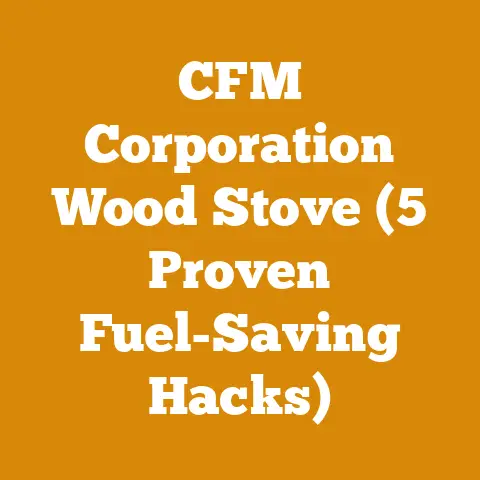Start-028 Chainsaw Repair Tips (5 Pro Fixes for Hot-Run Issues)
Introduction: The Eco-Tech Edge in Chainsaw Maintenance
Start-028 Chainsaw Repair Tips (5 Pro Fixes for Hot-Run Issues)
A chainsaw running hot is a serious sign that something is amiss. Ignoring it can lead to engine seizure, premature wear, and costly repairs. Let’s dive into the common causes and how to address them.
1. Fuel System Issues: The Root of the Problem
A lean fuel mixture is often the primary culprit behind a hot-running chainsaw. This means there’s too much air and not enough fuel entering the engine.
Understanding the Lean Mixture:
- The Science: A lean mixture causes the engine to run hotter because the combustion process isn’t properly cooled by the fuel.
- The Symptoms: Besides overheating, you might notice a lack of power, difficulty starting, and an erratic idle.
Fix 1: Carburetor Adjustment
The carburetor is responsible for mixing fuel and air. A misadjusted carburetor can easily lead to a lean mixture.
- The Process: Most chainsaws have three adjustment screws: “H” (high-speed), “L” (low-speed), and “LA” (idle adjustment).
- H Screw: Controls the fuel mixture at high RPMs.
- L Screw: Controls the fuel mixture at idle and low RPMs.
- LA Screw: Sets the idle speed.
- The Adjustment:
- Locate the Screws: Consult your chainsaw’s manual for the exact location.
- Initial Setting: Start with the manufacturer’s recommended settings. Typically, this involves turning the “H” and “L” screws all the way in and then backing them out a specific number of turns (usually 1 to 1.5 turns).
- Fine-Tuning:
- Start the chainsaw and let it warm up.
- Adjust the “L” screw until the engine idles smoothly without stalling.
- Adjust the “H” screw while the engine is running at full throttle. The goal is to find the point where the engine runs smoothly without bogging down or sputtering.
- Use a tachometer if possible to ensure you are within the recommended RPM range.
- Important Note: Be careful not to overtighten the screws. This can damage the carburetor.
- Cost Considerations:
- Do-It-Yourself (DIY): Free (assuming you have a screwdriver).
- Professional Adjustment: $30-$75 (depending on the shop and location).
Fix 2: Fuel Filter Replacement
A clogged fuel filter restricts fuel flow, leading to a lean mixture.
- The Process:
- Locate the Fuel Filter: It’s usually inside the fuel tank, attached to the fuel line.
- Remove the Filter: Use a small hook or wire to pull the filter out of the tank.
- Inspect the Filter: If it’s dirty or clogged, replace it.
- Install the New Filter: Attach the new filter to the fuel line and insert it back into the tank.
- Cost Considerations:
- Fuel Filter: $5-$15.
- Time: 15-30 minutes.
Fix 3: Fuel Line Inspection and Replacement
Cracked or damaged fuel lines can leak air, disrupting the fuel mixture.
- The Process:
- Inspect the Fuel Lines: Check for cracks, kinks, or leaks. Pay close attention to the areas where the lines connect to the carburetor and fuel tank.
- Replace Damaged Lines: If you find any damage, replace the fuel lines. Use fuel-resistant tubing of the correct size.
- Cost Considerations:
- Fuel Line Tubing: $10-$20 per foot.
- Time: 30-60 minutes.
2. Cooling System Blockages: Preventing Overheat
A chainsaw engine relies on airflow to dissipate heat. Blockages in the cooling system can cause the engine to overheat quickly.
Understanding Cooling System Function:
- The Science: Air is drawn in through the engine’s cooling fins and directed over the cylinder and cylinder head to remove heat.
- The Culprits: Sawdust, debris, and even grass clippings can accumulate in the cooling fins, blocking airflow.
Fix 4: Cleaning Cooling Fins
Regularly cleaning the cooling fins is crucial for preventing overheating.
- The Process:
- Access the Cooling Fins: Remove the engine cover to access the cooling fins.
- Remove Debris: Use a brush, compressed air, or a small vacuum to remove any accumulated debris.
- Inspect for Damage: Check the fins for any damage that could restrict airflow.
- Reassemble: Replace the engine cover.
- Cost Considerations:
- DIY: Free (assuming you have a brush and compressed air).
- Time: 15-30 minutes.
My Personal Experience:
I once neglected cleaning the cooling fins on my chainsaw after a particularly dusty logging job. The engine overheated and seized, resulting in a costly repair. Now, I make it a point to clean the cooling fins after every use, regardless of how clean I think the job was.
3. Spark Arrestor Screen: Ensuring Proper Exhaust Flow
The spark arrestor screen prevents sparks from escaping the exhaust system, reducing the risk of fires. However, it can also become clogged with carbon deposits, restricting exhaust flow and causing the engine to overheat.
Understanding Spark Arrestor Function:
- The Science: The spark arrestor screen is a fine mesh screen that traps sparks.
- The Problem: Over time, carbon deposits can build up on the screen, restricting exhaust flow and causing the engine to run hotter.
Fix 5: Cleaning or Replacing the Spark Arrestor Screen
- The Process:
- Locate the Spark Arrestor: It’s usually located on the muffler.
- Remove the Screen: Remove the screws or clips that hold the screen in place.
- Clean the Screen: Use a wire brush to remove carbon deposits. You can also soak the screen in carburetor cleaner.
- Inspect the Screen: If the screen is damaged or heavily corroded, replace it.
- Reassemble: Reinstall the screen and secure it with the screws or clips.
- Cost Considerations:
- Spark Arrestor Screen: $5-$20.
- Carburetor Cleaner: $5-$10.
- Time: 15-30 minutes.
4. Ignition Timing Issues
While less common, incorrect ignition timing can cause a chainsaw to run hot. This involves the spark plug firing at the wrong time in the engine cycle.
- The Science: Proper ignition timing ensures the fuel mixture ignites at the optimal moment for efficient combustion and power.
- The Symptoms: Hard starting, loss of power, and overheating.
Troubleshooting Ignition Timing:
- Check the Flywheel Key: The flywheel key aligns the flywheel with the crankshaft. If it’s sheared or damaged, it can throw off the timing.
- Inspect the Ignition Module: The ignition module generates the spark. A faulty module can cause erratic timing.
Repairing Ignition Timing:
- Replacing the Flywheel Key: Requires removing the flywheel and installing a new key. (Cost: $5-$10 for the key, 1-2 hours of labor if done professionally).
- Replacing the Ignition Module: Involves disconnecting the old module and installing a new one. (Cost: $20-$50 for the module, 1-2 hours of labor if done professionally).
Cost Considerations:
- DIY: Cost of parts plus your time.
- Professional Repair: $80-$200 (depending on the issue and shop rates).
5. Wrong Oil-Fuel Mixture
Using the incorrect oil-fuel mixture is a surefire way to damage your chainsaw engine. Most two-stroke engines require a 50:1 mixture (50 parts gasoline to 1 part two-stroke oil).
- The Science: Two-stroke oil lubricates the engine’s internal components. Using too little oil leads to increased friction and heat.
- The Problem: Overheating, piston scoring, and engine seizure.
Ensuring Proper Oil-Fuel Mixture:
- Use the Correct Ratio: Always follow the manufacturer’s recommendations for the oil-fuel mixture.
- Use High-Quality Two-Stroke Oil: Cheap oil can leave deposits and cause problems.
- Mix Fresh Fuel: Gasoline can degrade over time, especially when mixed with oil. Mix only what you need and use it within a few weeks.
Cost Considerations:
- High-Quality Two-Stroke Oil: $10-$20 per quart.
- Fuel Stabilizer: $5-$10 per bottle.
Cost Analysis and Budgeting for Chainsaw Maintenance
Maintaining a chainsaw involves more than just fixing problems as they arise. It’s about proactive maintenance and budgeting to ensure your equipment stays in top condition.
Breakdown of Chainsaw Maintenance Costs
- Routine Maintenance:
- Air Filter Cleaning/Replacement: $5-$15 (every 25 hours of use).
- Spark Plug Replacement: $5-$10 (every 100 hours of use).
- Bar and Chain Maintenance: $10-$20 (every use).
- Fuel Filter Replacement: $5-$15 (every 50 hours of use).
- Repair Costs:
- Carburetor Repair/Replacement: $50-$150.
- Piston/Cylinder Repair/Replacement: $100-$300.
- Ignition Module Replacement: $20-$50.
- Preventive Maintenance:
- Professional Tune-Up: $50-$100 (annually).
Data-Backed Cost Examples
- Average Chainsaw Repair Cost: According to a survey of chainsaw owners, the average repair cost is $80-$150.
- Cost of Downtime: A day of downtime due to a broken chainsaw can cost a professional logger $200-$500 in lost productivity.
- Fuel Costs: A chainsaw typically consumes 0.5-1 gallon of fuel per day, costing $2-$5 depending on fuel prices.
Budgeting Tips for Chainsaw Maintenance
- Create a Maintenance Schedule: Follow the manufacturer’s recommendations for routine maintenance.
- Keep a Log: Track all maintenance and repairs.
- Set Aside a Budget: Allocate a specific amount of money each month for chainsaw maintenance.
- Consider a Service Contract: If you rely heavily on your chainsaw, a service contract can provide peace of mind.
Global and Regional Cost Variations
Chainsaw maintenance costs can vary significantly depending on your location.
- Labor Rates: Labor rates for chainsaw repair vary widely from country to country.
- Parts Availability: The availability and cost of parts can also vary.
- Currency Exchange Rates: Fluctuations in currency exchange rates can affect the cost of imported parts.
Chainsaw Maintenance in Wood Processing and Firewood Preparation
Chainsaw maintenance is inextricably linked to the economics of wood processing and firewood preparation. Let’s delve into how these costs intertwine.
Wood Species and Quality
The type of wood you’re cutting significantly impacts your chainsaw’s wear and tear. Hardwoods like oak and maple require more power and put more strain on the engine and chain compared to softwoods like pine and fir.
- Hardwoods: Require more frequent chain sharpening and oiling.
- Softwoods: Tend to generate more sawdust, increasing the risk of cooling system blockages.
Cost Impact: Cutting hardwoods can increase your chain replacement costs by 20-30%.
Labor Costs in Logging and Firewood Handling
Whether you’re a professional logger or preparing firewood for personal use, labor costs are a significant factor. A well-maintained chainsaw can increase productivity and reduce labor costs.
- Logging Crew: A logging crew typically consists of a feller, skidder operator, and loader operator. Chainsaw downtime can idle the entire crew, resulting in significant losses.
- Firewood Preparation: A firewood handler can process 1-2 cords of wood per day with a well-maintained chainsaw. Downtime can reduce this output by 50% or more.
Cost Impact: Reducing chainsaw downtime can increase labor productivity by 10-20%.
Tool Costs: Chainsaws, Splitters, and More
Chainsaws are just one tool in the wood processing arsenal. Other tools include log splitters, skidders, and loaders. Proper maintenance of all these tools is essential for efficient and cost-effective wood processing.
- Log Splitters: Hydraulic log splitters can significantly reduce the time and effort required to split firewood.
- Skidders: Skidders are used to drag logs from the forest to a landing.
- Loaders: Loaders are used to load logs onto trucks.
Cost Impact: Investing in high-quality tools and maintaining them properly can increase overall productivity and reduce long-term costs.
Timber Prices and Fuelwood Market Rates
Understanding timber prices and fuelwood market rates is crucial for making informed decisions about wood processing and firewood preparation.
- Timber Prices: Timber prices vary depending on the species, quality, and location.
- Fuelwood Market Rates: Fuelwood market rates vary depending on the region and the type of wood.
Cost Impact: Knowing these rates can help you determine the profitability of your wood processing or firewood preparation project.
Case Study: Cost Management in Firewood Preparation
Let’s consider a case study of a small-scale firewood supplier.
Scenario: A firewood supplier processes 100 cords of wood per year. Their costs include:
- Timber Purchase: $50 per cord ($5,000 total).
- Chainsaw Maintenance: $500 per year.
- Log Splitter Maintenance: $300 per year.
- Labor: $20 per cord ($2,000 total).
- Fuel: $5 per cord ($500 total).
Total Costs: $8,300
Revenue: $100 per cord ($10,000 total).
Profit: $1,700
Opportunities for Cost Optimization:
- Reduce Chainsaw Maintenance Costs: By implementing a proactive maintenance program, the supplier could reduce chainsaw maintenance costs by 20%, saving $100 per year.
- Increase Labor Productivity: By using a more efficient log splitter, the supplier could increase labor productivity by 10%, reducing labor costs by $200 per year.
- Negotiate Timber Prices: By negotiating better timber prices, the supplier could reduce timber costs by 5%, saving $250 per year.
Potential Savings: $550 per year.
Practical Tips for Cost Optimization
Here are some practical tips for optimizing costs in wood processing and firewood preparation:
- Buy in Bulk: Purchase fuel and oil in bulk to save money.
- Maintain Your Equipment: Follow the manufacturer’s recommendations for routine maintenance.
- Sharpen Your Chains Regularly: A sharp chain cuts faster and reduces strain on the engine.
- Use the Right Chain for the Job: Different chains are designed for different types of wood.
- Store Your Chainsaw Properly: Store your chainsaw in a dry place to prevent rust and corrosion.
- Consider Renting Equipment: If you only need a log splitter or other specialized equipment occasionally, consider renting it instead of buying it.
- Take Advantage of Tax Deductions: If you’re a professional logger or firewood supplier, you may be able to deduct some of your equipment and maintenance costs.
Technical Explanations and Calculations
Understanding some basic technical concepts and calculations can help you make informed decisions about wood processing and firewood preparation.
Calculating Volume of Logs
- Board Feet: A board foot is a unit of measurement for lumber. It’s equal to 1 inch thick, 12 inches wide, and 12 inches long.
- Cords: A cord is a unit of measurement for firewood. It’s equal to a stack of wood that’s 4 feet high, 4 feet wide, and 8 feet long.
Formula for Calculating Board Feet:
Board Feet = (Thickness in inches x Width in inches x Length in feet) / 12
Formula for Calculating Cords:
Cords = (Height in feet x Width in feet x Length in feet) / 128
Estimating Drying Time
Firewood needs to be dried before it can be burned efficiently. The drying time depends on the species of wood, the climate, and how the wood is stacked.
- Softwoods: Typically dry in 6-12 months.
- Hardwoods: Typically dry in 12-24 months.
Factors Affecting Drying Time:
- Moisture Content: The initial moisture content of the wood.
- Climate: Temperature, humidity, and sunlight.
- Stacking Method: How the wood is stacked (e.g., loose stacks dry faster than tight stacks).
Actionable Takeaways and Next Steps
- Assess Your Chainsaw: Evaluate the condition of your chainsaw and identify any potential problems.
- Create a Maintenance Plan: Develop a routine maintenance schedule based on the manufacturer’s recommendations.
- Budget for Maintenance: Set aside a specific amount of money each month for chainsaw maintenance.
- Get Training: If you’re not comfortable performing chainsaw repairs yourself, consider taking a chainsaw maintenance course.
- Consult a Professional: If you encounter a problem that you can’t fix yourself, consult a qualified chainsaw repair technician.
Overcoming Challenges Faced by Small-Scale Loggers and Firewood Suppliers
Small-scale loggers and firewood suppliers face unique challenges, including limited access to capital, fluctuating market prices, and competition from larger companies.
- Access to Capital: Securing financing for equipment and operations can be difficult.
- Market Prices: Timber and fuelwood prices can fluctuate significantly, making it difficult to plan and budget.
- Competition: Larger companies often have economies of scale that small-scale operators can’t match.
Strategies for Success:
- Focus on Niche Markets: Specialize in a particular type of wood or service.
- Build Relationships: Develop strong relationships with suppliers and customers.
- Embrace Technology: Use technology to improve efficiency and reduce costs.
- Collaborate: Partner with other small-scale operators to share resources and expertise.
Compelling Phrases and Technical Terms
- “A Stitch in Time Saves Nine”: Addressing minor chainsaw problems early can prevent major repairs later.
- “Penny Wise, Pound Foolish”: Investing in high-quality parts and maintenance can save money in the long run.
- “Chain Shot”: A dangerous situation where a chainsaw chain breaks and becomes a projectile.
- “Kickback”: A sudden and forceful upward movement of the chainsaw, which can cause serious injury.
- “Kerf”: The width of the cut made by the chainsaw chain.
- “Two-Stroke Engine”: An engine that completes a power cycle with two strokes of the piston.
- “BTU (British Thermal Unit)”: A unit of measurement for heat energy.
Conclusion
Maintaining a chainsaw is essential for efficient and cost-effective wood processing and firewood preparation. By understanding the common causes of hot-run issues and implementing the pro fixes outlined in this guide, you can keep your chainsaw running smoothly and extend its lifespan. Remember to budget for routine maintenance, track your costs, and take advantage of opportunities for cost optimization. Embrace the growing eco-tech movement by exploring sustainable options for bar and chain oils, and consider the long-term benefits of electric chainsaws. With a proactive approach and a little bit of knowledge, you can ensure that your chainsaw remains a valuable asset for years to come.






